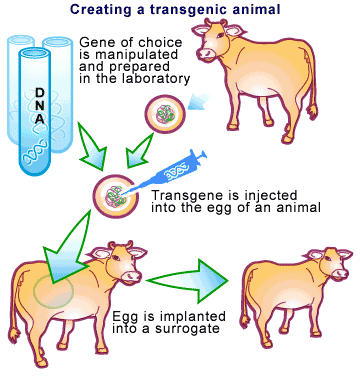First, what are transgenic animals? Transgenic animals are when their genome, which is responsible for human characteristics, has been deliberately altered by a gene or group of genes from another species or breed.

Transgenic animals are produced by numerous methods. However the three principal methods are DNA microinjection, Retrovirus-Mediated gene transfer, and Embryonic stem cell-mediated gene transfer. The most common is through DNA microinjection also known as physical transfection. This is the process of taking the DNA of a different or the same species and injecting it into the pro-nucleus of a fertilized ovum. Inserting the DNA is random but there is a high probability that the gene that’s introduced will not insert into a site on the host DNA that will permit its expression. This method has a major advantage as it is applicable to wide varieties. This is only one of the three principal methods of creating transgenic animals. Retrovirus-Mediated gene transfer involves retroviruses used as vectors, an organism that transmits a disease from one animal, to transfer genetic material into the host cell. A retrovirus is a virus that carries its genetic information in the form of RNA instead of DNA. Offspring gained from this method result in a chimera, an organism consisting of tissues or parts of genetic constitution. Embryonic stem cell-mediated gene transfer involves the isolation of totipotent stem cells (stem cells that can develop into any type of specialized cell) from embryos. The desired gene is inserted into these cells containing the desired DNA and are incorporated into the host’s embryo, resulting in a chimeric animal.
Here is an example of how a transgenic animal is produced using the gene of a cow:

http://people.ucalgary.ca/~browder/transgenic.html
Transgenic animals are best used as models in biomedical research for the research of human diseases. This allows them to understand the gene function in the context of disease susceptibility, progression and used to determine responses to a therapeutic intervention. Ninety-five percent of transgenic animals that are tested are genetically modified rodents, mainly mice. They have been genetically modified to naturally produce human antibodies for use as therapeutics. There are also transgenic farm animals that produce large quantities of complex human proteins for the treatment of human disease.
Transgenic animals can be used to cure diseases such as diabetes. The method used is called transplantation which involves the process of taking the cells in the animal that produce insulin, which is made from beta cells in the pancreas and transplanting it to the diabetes patients so they won’t have to inject the insulin. Transplantation is a very difficult process without having a whole body. Transplantation is the body of the Islet of Langerhans which are bundles of cells that contain and introduce the insulin producing cells. When you transplant them, you need to get a new blood supply and a new nerve supply which is why it would be a difficult process without an animal. Although, this method has worked, it can only be used for a few number of people as it is risky. Patients will need to go on immuno suppression drugs so that’s why most just take insulin instead.
Transgenic animals can keep infants healthy by the process of transgenesis, modifying the genes of the parent animal that can produce an offspring with qualities that humans can use. Scientists have discovered how cows can produce milk with casein, a type of protein used for cheese manufacturing by modifying the cow. These cows can also produce lactoferrin (a protein present in milk and other secretions, with bactericidal and iron-binding properties), which can be found in the immune system. This can be used as an additive to infant formula.
http://www.animalresearch.info/en/medical-advances/diseases-research/diabetes/
http://www.whatisbiotechnology.org/science/transgenic

Transgenic cows like this one produce a natural protein in their milk that kills the bacteria that cause animal mastitis which is inflammation of the mammary gland in the breast or udder.
Transgenic animals have the potential to improve human welfare in agriculture, medicine and industry. Agriculture was time-consuming for farmers but now that the molecular biology was made, it was easy to develop traits in animals in a shorter period and with more precision which is an easy way for farmers to increase yields. The quality of the products that the animals produce has also improved and the animals are healthier. For example, transgenic chickens produce eggs that have more protein added to generate antibodies to fight cancer and some have less cholesterol. The cows milk will produce more cheese efficiently and animals who have less fat are said to be healthier. Transgenic animals can also be organ donors in the future. Pigs have organs like humans in size and are readily available but their tissues age must faster. Proponents say that there will be a time where animal organs can be used on people who are waiting for donors. This would help organ donors who don’t have to be on a wait list and the process would be much quicker and efficient. Toxicity-sensitive transgenic animals have also been produced for chemical-safety testing. They have been engineered to produced a wide variety of proteins which can then produce enzymes which can speed up industrial chemical reactions.
http://www.actionbioscience.org/biotechnology/margawati.html
http://connectusfund.org/9-biggest-pros-and-cons-of-transgenic-animals
https://www.bio.org/articles/genetically-engineered-animals-frequently-asked-questions

In this picture, a mouse grew an ear on its back which can be cut off and donated to someone who needs an ear.
In conclusion, transgenic animals plays a critical role in developing and discovering new drugs for diseases. This enables scientists to study the function of specific genes which enhances the study of the disease biology and facilitates the development of the drug to target the specific disease.